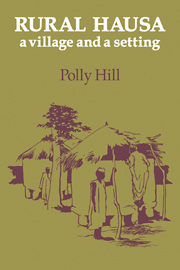Book contents
- Frontmatter
- Contents
- List of tables
- List of illustrations
- Preface
- List of abbreviations and conventions
- Map of Hausaland (after Morgan and Pugh, 1969)
- I Introduction
- II Batagarawa
- III Fathers and sons in gandu
- IV The evidence for economic inequality
- V Further aspects of inequality
- VI The sale of manured farmland
- VII Migration
- VIII Farm-labouring
- IX Local trade in grains and groundnuts
- X Individual poverty
- XI Individual viability
- XII Short-term stability
- XIII The absence of ‘class’
- XIV Concluding speculations
- Commentary, including Hausa glossary
- Bibliography
- Index
IV - The evidence for economic inequality
Published online by Cambridge University Press: 05 May 2010
- Frontmatter
- Contents
- List of tables
- List of illustrations
- Preface
- List of abbreviations and conventions
- Map of Hausaland (after Morgan and Pugh, 1969)
- I Introduction
- II Batagarawa
- III Fathers and sons in gandu
- IV The evidence for economic inequality
- V Further aspects of inequality
- VI The sale of manured farmland
- VII Migration
- VIII Farm-labouring
- IX Local trade in grains and groundnuts
- X Individual poverty
- XI Individual viability
- XII Short-term stability
- XIII The absence of ‘class’
- XIV Concluding speculations
- Commentary, including Hausa glossary
- Bibliography
- Index
Summary
In a community like Batagarawa where there are no land-owning classes, clans or lineages and no privileged groups with special rights over other scarce factors such as water; where land is plentiful and there is no landless class; where there is no slavery or serfdom or ethnically inferior group; where there is little property of any kind (other than land or houses) with a life of more than a few years – in such a community it might be thought that a man's standard of living would be largely determined by the size of his family labour-force in relation to the number of his non-working dependants. Since most resident married sons remain in gandu with their fathers, then (questions of migration apart) farmers would tend to get richer as they got older and had more adult sons. Of course, rich men might have more sons because in this polygynous society, where marriage expenses are high and wives are secluded, they could afford to marry, and maintain, more wives – in which case the number of sons is not necessarily an independent variable. But the general approach to economic inequality would have to be demographic.
One of the main themes of this book is that such a demographic approach is misleadingly rigid and deterministic – that, for example, there are many reasons why an individual who is the proud father of several sons cannot rely on becoming involved in a benign developmental process as those sons grow up.
- Type
- Chapter
- Information
- Rural HausaA Village and a Setting, pp. 57 - 70Publisher: Cambridge University PressPrint publication year: 1972

